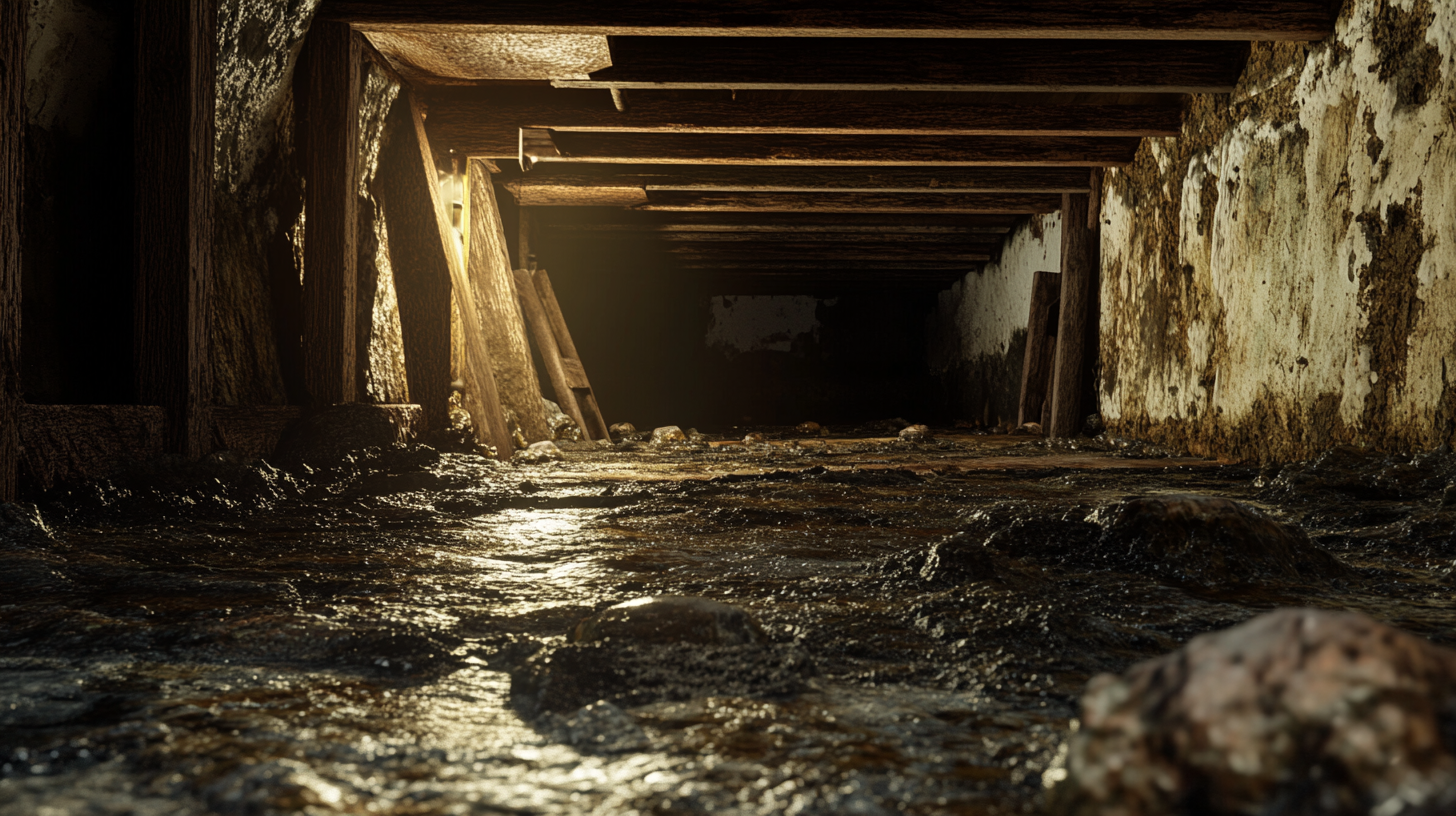Now IS THe Time To...

Crawl Space Services In Knoxville, TN
Stetson Howard: 865-432-6743
CRAWL SPACE ENCAPSULATION, REPAIR, WATERPROOFING & MOLD REMOVAL
No-Obligation, Free Inspections
No-Obligation Free Estimates
We Warranty All of Our Work
100% Satisfaction Guaranteed
Welcome to our comprehensive exploration of home waterproofing, a critical aspect of home maintenance that goes beyond structural integrity and directly impacts the health and well-being of residents. This blog delves into the often-overlooked connection between effective waterproofing and maintaining a healthy living environment.
The Vital Role of Waterproofing in Health
Waterproofing your home is not just about preventing water damage; it plays a pivotal role in creating and sustaining a healthy living space. Inadequate waterproofing can lead to moisture accumulation and dampness, conditions that are not merely inconveniences but potential health hazards.
How Moisture and Dampness in Homes Can Affect Health
Mold and Mildew Growth: Excess moisture is the perfect breeding ground for mold and mildew, which can release spores and toxins into the air, leading to respiratory issues, allergies, and other health problems.
Structural Dampness: Chronic dampness in a home can contribute to a host of health issues, including aggravating asthma, respiratory infections, and potentially leading to more serious conditions like chronic obstructive pulmonary disease (COPD).
Indoor Air Quality: The presence of dampness and mold can significantly deteriorate indoor air quality, which is crucial for health, especially considering the amount of time spent indoors.
In this blog, we will explore the various aspects of home waterproofing, from basic concepts to advanced techniques, and how they contribute to a healthier living environment. We will also discuss the health implications of moisture and dampness in homes, providing insights into why waterproofing is an essential investment for not just your home, but also your health.
Join us as we navigate the crucial link between home waterproofing and health, highlighting the importance of keeping your living spaces dry and safe for the well-being of you and your family.
Understanding the Link Between Home Humidity and Health
The humidity level in your home is more than a comfort issue; it's a crucial factor affecting both the health of the living environment and its occupants. This section will delve into the science of moisture in homes, its impact on air quality, and the health risks associated with damp living spaces.
The Science of Moisture in Homes
Explanation of How Moisture Enters and Accumulates in Homes
- Moisture can enter homes in various ways, including through leaks and seepage from the outside, condensation from daily activities like cooking and showering, and even through vapor diffusion. Poor ventilation exacerbates the issue by trapping moist air inside.
- Homes in wet climates or with inadequate waterproofing are particularly susceptible to moisture accumulation, leading to higher indoor humidity levels.
The Relationship Between Home Humidity Levels and Air Quality
- The level of humidity in a home directly impacts its air quality. Ideal indoor humidity levels should range between 30-50%. Higher levels can foster the growth of mold, dust mites, and other allergens, while too low humidity can cause respiratory irritation and discomfort.
- Properly managing home humidity involves balancing moisture sources, adequate ventilation, and, in some cases, the use of dehumidifiers or humidifiers to maintain healthy levels.
Common Health Risks Associated with Damp Homes
Introduction of Health Issues Caused by Dampness and Mold
- Damp homes, particularly those with mold growth, pose significant health risks. Mold spores and the toxins they produce can lead to respiratory problems, allergic reactions, and asthma attacks. People with existing respiratory conditions or weakened immune systems are especially vulnerable.
- Symptoms of mold exposure can include coughing, wheezing, throat irritation, nasal stuffiness, and skin irritation. In severe cases, it can lead to more serious respiratory infections.
Long-Term Health Effects of Living in a Moist Environment
- Prolonged exposure to damp and moldy environments can have long-term health effects. Chronic respiratory issues, ongoing allergic reactions, and a general decline in health are commonly reported.
- The psychological impact of living in a damp, moldy environment should not be underestimated. It can lead to increased stress levels and anxiety, further impacting overall well-being.
Preventing Mold and Mildew through Waterproofing
Mold and mildew in homes are not just unsightly but can also pose significant health risks. Effective waterproofing plays a crucial role in preventing these issues. This section will explore the dangers of mold and mildew and introduce waterproofing strategies that can help in maintaining a healthy, mold-free home environment.
The Dangers of Mold and Mildew
Health Risks Posed by Mold and Mildew in Homes
- Mold and mildew can cause a variety of health problems, particularly for individuals with allergies, asthma, or compromised immune systems. Exposure to mold spores can lead to respiratory issues, allergic reactions, and in severe cases, more serious lung infections.
- The presence of mold and mildew can also significantly impact indoor air quality, contributing to a range of symptoms like headaches, fatigue, and skin irritation.
Conditions that Promote Mold Growth and How Waterproofing Can Prevent Them
- Mold thrives in moist, damp environments. Common conditions that promote mold growth include high humidity levels, water leaks, and condensation, often due to poor waterproofing and inadequate ventilation.
- Proper waterproofing helps prevent the accumulation of moisture in walls, ceilings, and floors – the primary areas where mold tends to grow. By creating a moisture barrier, waterproofing reduces the risk of mold and mildew development.
Effective Waterproofing Strategies Against Mold
Introduction of Waterproofing Methods That Help Prevent Mold and Mildew Growth
- Various waterproofing methods can be employed to combat mold growth. These include the use of waterproof paints and sealants, the installation of moisture barriers, and the application of waterproof coatings to exterior surfaces.
- In areas prone to high humidity, like basements and bathrooms, specialized waterproofing treatments can be particularly effective in keeping these spaces dry and mold-free.
Tips for Maintaining a Mold-Free Environment
- Regular inspections for leaks and moisture accumulation are essential. Addressing any water intrusion promptly can prevent the conditions mold needs to grow.
- Ensuring good ventilation, especially in areas like kitchens, bathrooms, and laundry rooms, is crucial. Using dehumidifiers in particularly damp areas can also help maintain lower humidity levels.
- After waterproofing, routine maintenance of these systems is key. This includes cleaning gutters, inspecting roofs, and ensuring that drainage systems are functioning properly.
Enhancing Indoor Air Quality with Waterproofing
The quality of the air we breathe indoors is often something we take for granted. However, it plays a crucial role in our health and well-being. Waterproofing, surprisingly, is a significant factor in maintaining and enhancing indoor air quality. This section will explore how waterproofing contributes to better air quality and the synergy between waterproofing and ventilation.
Role of Waterproofing in Improving Air Quality
How Waterproofing Contributes to Better Indoor Air Quality
- Effective waterproofing prevents moisture and water infiltration, which are primary causes of mold and mildew growth in homes. Mold spores and the musty odors they produce can significantly degrade indoor air quality, leading to respiratory issues and allergic reactions.
- By creating a moisture barrier, waterproofing helps maintain a dry and stable indoor environment, reducing the likelihood of mold growth and ensuring cleaner, healthier air inside the home.
The Impact of Good Air Quality on Overall Health and Well-Being
- Good indoor air quality is essential for maintaining respiratory health, reducing the risk of allergy symptoms, and preventing the onset of asthma-related issues. It also contributes to overall comfort and well-being, as fresh, clean air is more pleasant and comforting to live in.
- In the long term, maintaining high indoor air quality can have significant health benefits, including reduced susceptibility to respiratory infections and improved sleep quality.
Waterproofing and Ventilation Synergy
The Importance of Combining Waterproofing with Proper Ventilation
- While waterproofing is effective in preventing moisture ingress, it needs to be complemented with proper ventilation to ensure optimal indoor air quality. Ventilation helps in regulating indoor humidity levels and prevents the accumulation of stale air, which can carry pollutants.
- In waterproofed areas, especially basements and bathrooms, where natural airflow might be limited, additional ventilation solutions are crucial to prevent air stagnation.
Strategies for Ensuring Effective Air Circulation in Waterproofed Areas
- Installing exhaust fans, especially in areas like bathrooms and kitchens, can help expel moist air and draw in fresh air.
- For basements and other enclosed spaces, consider using dehumidifiers to control humidity levels and ensure that any installed HVAC systems include proper air filtration to maintain clean air circulation.
- Regular maintenance of waterproofing and ventilation systems is key. This includes checking for any leaks or damages in waterproofing membranes and ensuring that ventilation systems are clean and unobstructed.
Waterproofing to Combat Allergens and Irritants
Waterproofing your home is a crucial step not just in protecting its structure but also in creating a healthier living environment, particularly for those sensitive to allergens and irritants. This section will explore how waterproofing can reduce the presence of common allergens and benefit individuals with allergies or respiratory issues.
Reducing Allergens in the Home
How Waterproofing Reduces the Presence of Allergens
- Waterproofing plays a significant role in reducing indoor allergens such as dust mites, pet dander, and mold spores. By preventing moisture intrusion, waterproofing helps to create an environment that is less hospitable to these allergens. Dust mites, for instance, thrive in humid conditions, and waterproofing can help keep indoor humidity levels in check.
- Mold, a common allergen, is effectively controlled by waterproofing measures that prevent water seepage and dampness, conditions that mold requires to grow.
Waterproofing Materials and Methods That Help in Allergen Reduction
The use of moisture barriers, sealants, and dehumidifiers in basements and other prone areas can significantly reduce the likelihood of damp conditions that foster allergens.
Choosing waterproofing materials that are low in volatile organic compounds (VOCs) also helps in reducing indoor air pollutants, contributing to a healthier indoor environment.
Minimizing Irritants for Sensitive Individuals
Benefits of Waterproofing for People with Allergies or Respiratory Issues
- For individuals with allergies, asthma, or other respiratory conditions, waterproofing can be a game-changer. By reducing the levels of mold spores and dust mites in the home, waterproofing can alleviate symptoms like sneezing, coughing, and respiratory discomfort.
- A well-waterproofed home also contributes to overall better air quality, reducing the triggers for asthma attacks and allergic reactions.
Case Studies or Examples of Improved Health Outcomes
- Case studies have shown that homes with effective waterproofing and humidity control see a marked decrease in the incidence and severity of allergy and asthma symptoms among residents.
- An example includes a study where the implementation of comprehensive waterproofing and moisture control measures led to a significant reduction in emergency room visits for asthma and respiratory issues among the occupants.
Structural Integrity and Health
The health of a building is intrinsically linked to the health of its inhabitants. A structurally sound home provides a safe and healthy environment, while a compromised structure can pose significant health risks. This section will explore the connection between building health and human health, emphasizing the role of waterproofing in maintaining structural integrity and a healthy living environment.
The Connection Between Building Health and Human Health
How the Structural Integrity of a Home Affects Its Inhabitants' Health
- The structural integrity of a home directly impacts the safety and well-being of its occupants. Issues like mold growth, poor indoor air quality, and exposure to harmful substances are often the result of structural problems such as leaks, dampness, and water damage.
- A structurally compromised building can also lead to physical hazards, such as the risk of falling debris or the collapse of weakened structures, posing direct physical threats to inhabitants.
The Role of Waterproofing in Maintaining a Healthy Living Environment
- Waterproofing is a key factor in preserving the structural integrity of a building. By preventing water ingress, it helps avoid conditions that can lead to mold growth, wood rot, and the deterioration of building materials.
- Effective waterproofing ensures that indoor environments remain dry and free from dampness-related issues, contributing to healthier air quality and reducing the risk of respiratory problems and other health concerns associated with mold and mildew.
Preventing Structural Deterioration
- How Waterproofing Prevents Deterioration That Can Lead to Health Hazards
- Waterproofing acts as a barrier against moisture, which is a primary cause of structural deterioration. By keeping water out, it prevents the weakening of structural elements like walls, floors, and foundations.
- Deterioration such as crumbling walls or exposed insulation can release particles or toxic materials into the air, which can be harmful if inhaled. Waterproofing helps maintain the integrity of these structures, thereby preventing such exposure.
- In cases where buildings contain hazardous materials like asbestos or lead, which were used in older constructions, waterproofing plays a crucial role in containing these materials and preventing them from becoming airborne due to structural breakdown.
FAQs
Recent Blog Posts
Crawl Space News







